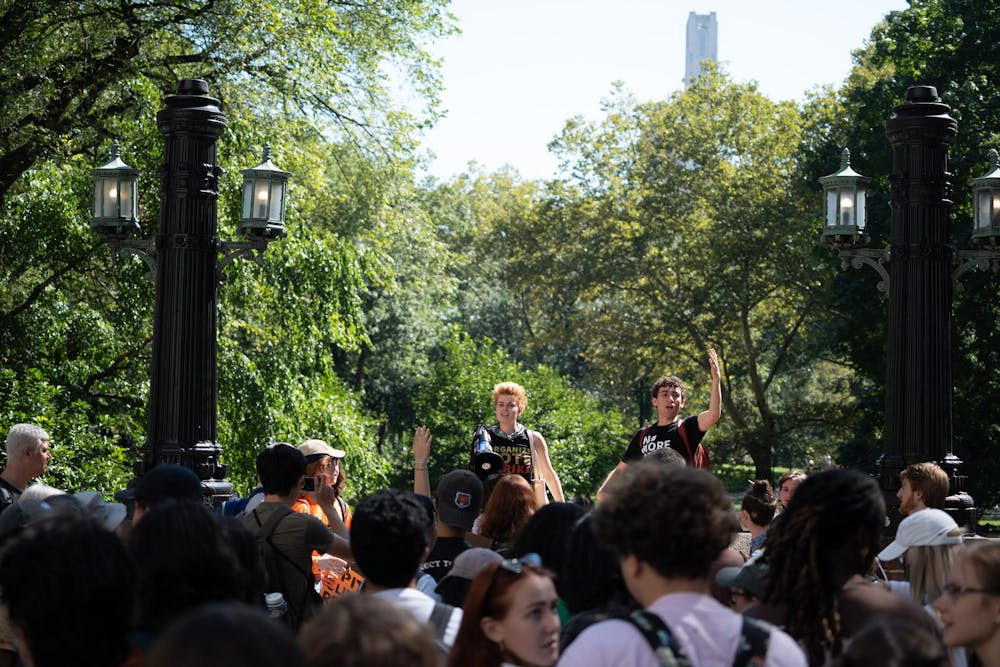This September, Sunrise Princeton, the climate activism group that I organize with, published a startling revelation: Princeton University owns a majority stake in an oil and gas company called PetroTiger.
At Monday’s Council of the Princeton University Community meeting, the University’s Vice President for Finance and Treasurer Jim Matteo, casually mentioned that “there is no set timeline” for achieving a net-zero endowment, speaking on behalf of the Board of Trustees and PRINCO.
Princeton, it seems, feels no urgency to end its funding of the climate crisis.
This isn’t just about one university’s investment portfolio. It’s a microcosm of a larger, more troubling narrative: the institutions we trust to lead us into the future are entangled in the very industries pushing us toward an existential threat. The climate crisis is accelerating, uncertainties are piling up, and the risks may be far greater than previously imagined. Yet the response from Princeton’s leadership is a shrug of indifference.
Well, why should Princeton do more? After all, they only have $700 million invested in privately held fossil fuel companies. They're using the largest per-capita endowment in the world to decarbonize a whole four years before the entire globe needs to be net-zero to avert the worst. And is owning a vast majority stake in just one fossil fuel company really such a big deal.
But the science has changed since 2019, when Princeton was making its net-zero plans. For the 12-month period of June 2023 to May 2024, the average global temperature was 1.63 degrees Celsius above the pre-industrial (1850–1900) average. This is past the Paris Agreement’s ideal temperature threshold of 1.5 degrees Celsius and has started approaching the major danger zone of 2 degrees Celsius. An overshoot now is by no means a distant threat. But there’s still a sliver of time to pull back from the brink, before that warming is locked in for the long term.
Traditional economic models have lulled us into a false sense of security. Economist William Nordhaus’s model, for which he won the Nobel prize in 2018, predicted that 4 degrees Celsius of warming would result in a mere 4–5 percent loss of GDP.
But look under the hood. Nordhaus’s model relies on a bell curve where extreme events are statistically improbable.

Turns out, climate change doesn’t play by these rules. Events that should be incredibly rare according to Nordhaus’s normal distribution are becoming more common. Last year, Antarctic sea ice hit a once-per-2.7-million-year low, an alarming “six sigma” event showing our climate is destabilizing faster than expected.
The far-sighted, late economist Martin Weitzman saw this decades ago, arguing that we should consider climate scenarios a “fat-tailed” distribution, where the probability of extreme events is significant. In this model, there’s a non-zero chance of catastrophic warming scenarios that could lead to human extinction.
Weitzman’s perspective isn’t alarmist, its realist. The climate system is complex and riddled with uncertainties that traditional models fail to capture. The risks aren’t just higher than we thought — they’re incalculable.
Uncertainty has often been used as an excuse for inaction. But in the context of the climate crisis, uncertainty is a clarion call for urgent action. The less we know, the more cautious we should be -- and that means that Princeton needs to invest deeply in understanding, and responding to, the current climate landscape.

Our knowledge gaps are profound. Scientists still don’t know why 2023 was so hot. Risky feedback loops, like melting glaciers releasing more methane, aren’t fully accounted for. And recent studies suggest that warming of just 2 degrees Celsius could trigger catastrophic loss of the world’s ice.
The Greenland and Antarctic ice sheets are melting faster than anticipated, and if the Greenland ice sheet melts completely, sea levels could rise about 7 meters; the Antarctic, a staggering 60 meters. Consider this: at just 20 meters of sea-level rise, parts of Princeton would be underwater. Yale and Harvard fare worse, as usual.
All of this paints a grim picture, but it also underscores the urgency for action. We may permanently overshoot 1.5 degrees of warming, but that doesn’t mean we should throw up our hands in defeat. Every fraction of a degree matters. Every delay compounds the risks.
Princeton has a moral responsibility to lead. As a global resource of knowledge and innovation, the University is uniquely positioned to make a significant impact. Yet, its current trajectory is one of half-measures and complacency.
Yes, Princeton’s thermal storage and geo-exchange technology to reduce campus emissions is cutting-edge, thanks to the visionary work of people like Ted Borer. But one star player doesn’t make a winning team. Overall, Princeton’s plans to slow-walk emissions reductions until 2046 mirror the half-hearted efforts of many U.S. universities.
It’s not enough.
Looking at the science, it’s clear that we need an all-in approach. This should include rapid decarbonization aiming for net-zero emissions well before 2046; full divestment, including from private equity funds and any stakes in fossil fuel companies like PetroTiger; and cutting ties with fossil fuel companies, tapping into a tiny slice of our massively bloated endowment to replace their research funding.
We should also invest much more in climate research. The intellectual freedom that comes with rejecting fossil fuel money would allow for breakthroughs in clean energy technology, battery storage, decarbonizing industries like steel and cement, developing efficient carbon removal methods, and reducing the uncertainties that currently cloud our understanding of the climate system.
Princeton recently invested heavily in artificial intelligence, acquiring some of the most powerful supercomputers for research. Imagine if the same best-in-the-world commitment was directed toward innovation in climate science.
As Princeton stands at the crossroads between inaction and innovation, don’t look away. The reality is daunting, and the uncertainties are vast. But if we avert our gaze, the worst outcomes become inevitable. Facing the crisis head-on is the only path to a better future. In the face of infinite risk, indifference is indefensible.
Eleanor Clemans-Cope (she/her) is a junior from Rockville, Md. studying economics. She can be reached on Twitter at @eleanorjcc or by email at eleanor.cc[at]princeton.edu. Her column, “Eyes on the Tiger,” runs every two weeks on Wednesday. All of her columns can be read here.








